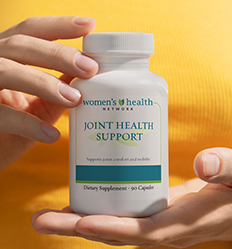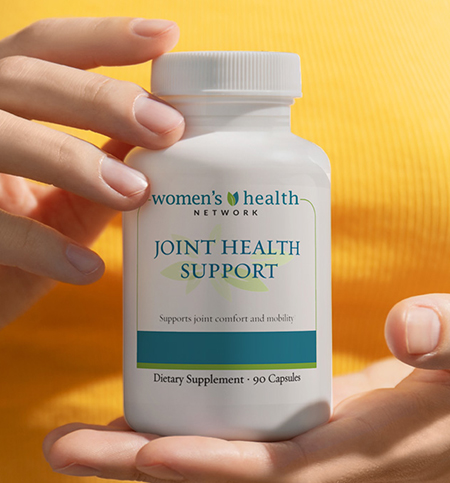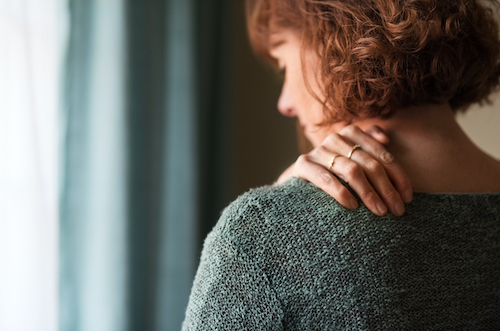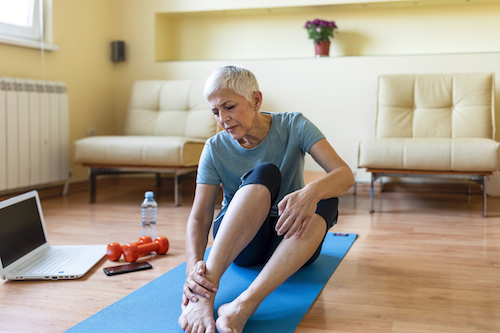Reviewed By Dr. Susan E. Brown, PhD
When your joints hurt, you may focus first on getting immediate pain relief. You might take an over-the-counter pain reliever but any benefits will just be temporary. Now what?

Conventional medicine usually offers two choices: prescription drugs that come with their own set of problems, and potentially surgery down the line. Instead, simply understanding what’s causing your symptoms allows you the opportunity to address — and resolve — joint issues at their source.
Joint aches and pains — what your symptoms are telling you
Are any of these making your joint pain worse?
For feet, ankles, knees, hips:
- Flip flops
- Ill-fitting shoes and boots
- Tennis, basketball, running
For hands, thumbs, wrists, elbows:
- Smart phones and hand-held devices
- Desktop computer set-up
- Heavy handbags, laptop cases
For neck, back, shoulders:
- Driving
- Watching TV lying on your side
- Poor workstation posture
- Sleeping on your stomach or side
- Lifting with your back
Joint pain is a clear signal from the body that something is going wrong and it can affect each woman a little differently.
Joint pain can cause a variety of different symptoms:
- Soreness — localized pain, throbbing.
- Stiffness — slowed movements, reduced flexibility after resting, difficulty bending and straightening affected area.
- Tenderness — sensitivity to touch, sudden pain with movement.
- Achiness — continuous dull pain, pulsing sensation.
- Burning — warm or “hot” sensation at site, tingling, searing or stinging pain.
- Loss of mobility — reduced range of motion, limping, difficulty going up or down stairs.
- Weakness — reduced grip strength, fatigued feeling in affected area, difficulty getting up from seated position.
- Swelling — puffiness at the site; dull, spreading pain; “tight” sensation.
- Rough, “grating” sensation — audible cracking sounds, gritty sensation during movement, sensation of bone grinding against bone.
- Stabbing or pinching sensation — sharp, shooting pains; reflex-like tensing.
- Numbness — deadened or an anesthetized sensation at affected site.
Joint issues make it extremely hard to move around or to do simple everyday tasks. They can stop you from savoring life’s little joys like hobbies, arts and crafts, cooking, gardening, taking care of children, and travelling. Exercising can seem impossible even though it’s a key factor in fighting daily joint pain.
It helps to know what’s causing your joint symptoms
When trying to pinpoint what’s causing your joint pain, know that there may be other factors at play too. Proactively targeting the true source of your joint pain will help you feel better now, and help stave off worse problems in the future.
Other causes of joint pain
- Muscle strain — injuries may occur near joints and lead to localized pain. When the muscle heals, the pain recedes.
- Carpal tunnel syndrome — characterized by pain and tingling in the hands and wrists, this can be caused by congenital predisposition, injury, repetitive-use work, stress and other conditions that lead to swelling, thickening and constriction of the median nerve in the arm.
- Ganglion cysts — usually on wrists or hands but also sometimes on ankles and feet, these fluid-filled sacs can press painfully on nearby nerves and sometimes interfere with movement.
- Reactive arthritis or Reiter’s syndrome — affecting 4-5 joints at a time in people between the ages of 20-40, this is usually generated by an infection, often in the intestines, genitals or urinary tract.
You might assume your joint pain stems from osteoarthritis, the most common form of arthritis, and millions of people suffer from it to varying degrees. With osteoarthritis, the layer of protective cartilage on the ends of the bones that make up the joint wears away over time, leading to inflammation and pain.
Genetics, and the way you use your body and joints, can both lead to osteoarthritis and age plays a role too. Paying attention to joint issues early on presents a chance to slow any degeneration of the joint.
Tracking down the source of your joint pain
Pain increases as the ligaments and tendons near the affected joint are strained or stretched. Your body uses the inflammatory process to help out, though it’s supposed to be just temporary.
Inflammation brings on swelling that presses on nerves and causes additional pain and a hot sensation in the joint. But if the source of the problem isn’t shut down, inflammation becomes chronic, worsening joint pain and leading to a cascade of other problems.
- Earlier injuries: If you’ve had a previous injury at the affected joint — perhaps one that never healed correctly — you may experience more inflammation-driven stiffness and pain years later. You may subconsciously change how you move so the joint hurts less. But that can shift your body out of alignment, unleashing a domino effect of other alignment issues.
- Sex hormone imbalances: Since reproductive hormones are associated with inflammation, midlife is prime time for joint pain. Estrogen, which has a naturally anti-inflammatory effect, begins to fluctuate, often plunging and spiking erratically. This is why many women first notice joint issues during perimenopause.
Note: there’s an early warning system for joint pain related to hormonal imbalances: if you have irregular periods and terrible PMS as a younger woman, it makes you more likely to have joint issues later in life. Working to restore hormonal balance as soon as possible may help reduce this risk.
- Stress and cortisol: Inflammation-driven joint pain can also be a problem if you’re under stress for long periods. Your adrenal glands make more and more of the hormone cortisol to keep you on track because your body interprets your stress as a life-threatening emergency. Sustained high cortisol is tightly linked to chronic inflammation.
- Weight: Weight can work against you when it comes to joint pain and arthritis. Being overweight makes you four to five times more likely to have knee osteoarthritis and may increase the likelihood of cartilage and bone marrow defects. Just 10 extra pounds adds an extra 50-60 pounds of force on your knee — with each step. Excess body fat can also make aches and pains worse because it produces inflammation-promoting substances and may be linked to osteoarthritis in other joints, including the hands.
How to make your joints feel better
Most conventional doctors have no real, long-term solution for joint issues and basically tell you to live with your joint pain. Seriously deteriorated joints, or those with missing cartilage or damage to tendons or ligaments, are not reparable. But it’s very important to investigate the source of your joint pain as soon as possible because for most kinds of joint pain, there is help.
From the food you eat to your activity level to your emotional health, many separate elements can feed inflammation. For women enduring everyday joint pain, real relief is possible with a combination approach that targets the sources of inflammation. It’s a natural way to feel better, and its benefits extend to your bones and the rest of your body.
Here’s what we recommend:
1. Take aim at joint issues. There are safe and effective herbal ingredients that support joint health and help with the oxidative effects of the inflammation process. Look for some or all of these in a high quality joint health supplement:
Glucosamine Sulfate – Glucosamine is an essential precursor for the synthesis of connective tissues, including cartilage, tendons and ligaments. Without sufficient glucosamine, joints can deteriorate — leaving you in pain. Glucosamine also helps regulate inflammation, increasing joint comfort. When supplementing, look for glucosamine sulfate, a highly absorbable and effective source of glucosamine.
Chondroitin – this naturally occurring compound assists in synthesizing new joint cartilage and also helps in regulating the inflammatory response. Chondroitin sulfate is a major component of proteoglycan aggrecan, the essential component of cartilage tissue.
Quercetin — a plant-derived flavonol believed to have antioxidant properties, quercetin is found throughout the natural world. Quercetin protects connective tissue cells from free radical damage and helps to quiet inflammation, improving joint mobility and comfort.
Turmeric – the turmeric plant (Curcuma longa) provides potent antioxidant and anti-inflammatory effects to protect connective tissue at the cellular level. Curcumin, the active compound in turmeric, is well-studied for its help with symptoms of osteoarthritis.
MSM (methylsulfonymethane) — a safe, natural organosulfur compound used widely by people with arthritis. MSM assists in the synthesis and maintenance of connective tissues.
Bromelain — an enzyme found in pineapple juice and stems, bromelain is a traditional remedy for joint swelling and soreness.
Boswellia — well-studied and safe, this plant extract from the bark of the frankincense tree is considered to have anti-inflammatory and analgesic properties. Boswellia can help to reduce joint stiffness and improve the physical and functional ability of joints by increasing blood flow to connective tissue. It also has a history of use for knee issues.
Methionine – an essential amino acid that must be obtained from diet or supplementation, methionine is an antioxidant free radical scavenger that helps reduce inflammation in joints.
2. Eat right for healthy joints. Following an alkaline diet is best for joints because we now know just how much food influences the inflammation process and subsequently joint discomfort. Foods that promote inflammation — processed and fried foods, meats, dairy products, grains and sugary foods — are acid-producing. To keep you alive, your body must neutralize that acid, often by stealing minerals from your bones. Following an alkaline diet with lots of vegetables, greens and fruits helps prevent that by maintaining a healthy pH balance in your body. It may even help with weight loss, which can also benefit joints.
3. Make exercise easy. Physical movement is crucially important to maintain joint health, flexibility and stability. But if you have aches and pains, you may not feel much like exercising. Start off with slow, easy stretches and enjoy some easy walking, which naturally lubricates the joints and promotes good circulation. Check with your healthcare practitioner for guidance before starting a new exercise plan.
If you have joint issues, it’s hard to find the relief you need to keep up with the demands of your life. Conventional medical practitioners may not know about the range of options available but there is a lot you can do — right now. You can improve how your joints feel today while supporting good joint health in the future.
Freeman EW1, Sammel MD, Lin H, Gracia CR, Pien GW, Nelson DB, Sheng L. Symptoms associated with menopausal transition and reproductive hormones in midlife women. Obstet Gynecol. 2007 Aug;110(2 Pt 1):230-40. https://www.ncbi.nlm.nih.gov/pubmed/17666595
https://www.urmc.rochester.edu/encyclopedia/content/?ContentTypeID=167&ContentID=cortisol_serum
https://www.sciencedaily.com/releases/2012/04/120402162546.htm
https://www.mayoclinic.org/diseases-conditions/reactive-arthritis/basics/symptoms/con-20020872
https://www.ninds.nih.gov/disorders/carpal_tunnel/detail_carpal_tunnel.htm
https://www.mayoclinic.org/diseases-conditions/ganglion-cyst/basics/definition/con-20023936
https://www.veteransmemorialhospital.com/index.php?option=com_content&view=article&id=369:does-being-overweight-actually-cause-arthritis-of-the-knees-or-simply-make-arthritis-worse-for-people-who-already-have-it&catid=7:wellness-vmh&Itemid=162
Role of Body Weight in Osteoarthritis
https://www.webmd.com/vitamins-and-supplements/lifestyleGuide-11/supplement-guide-turmeric
https://www.mayoclinic.org/diseases-conditions/arthritis/expert-answers/msm/faq-20058526
https://www.webmd.com/vitamins-supplements/ingredientmono-830-new%20zealand%20green-lipped%20mussel/?activeingredientid=830&activeingredientname=new%20zealand%20green-lipped%20mussel
https://umm.edu/health/medical/altmed/herb/ginger
https://www.webmd.com/arthritis/features/arthritis-diet-claims-fact-fiction
Kimmatkar N1, Thawani V, Hingorani L, Khiyani R. Efficacy and tolerability of Boswellia serrata extract in treatment of osteoarthritis of knee–a randomized double blind placebo controlled trial. Phytomedicine. 2003 Jan;10(1):3-7. https://www.ncbi.nlm.nih.gov/pubmed/12622457












